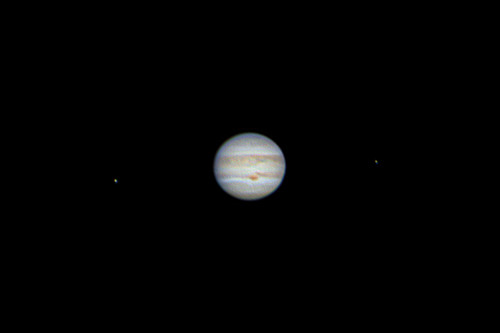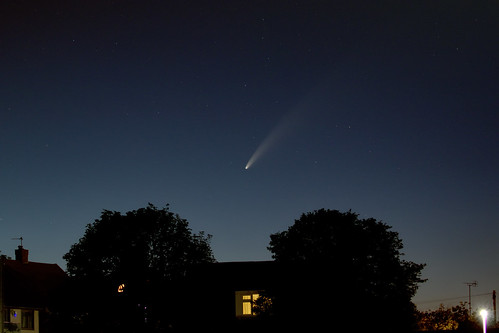14-15 May 2020, 22:30 – 3:15
Conditions: Chilly, breezy; sky noticeably lighter along the northern horizon.
Seeing: Good
Transparency: Good overhead, average to poor everywhere else
M61, galaxy, Virgo
With the Virgo cluster already sliding past the meridian by the time it gets dark I wasn’t expecting to look at M61 again this year, but I’ve never seen a supernova before so I had to at least try to spot SN 2020jfo. After several minutes of careful observing (at 171x), using averted vision and enhanced breathing and all the usual tricks, I could intermittently see one or two faint stars west of the nucleus. So did I see it or was my mind filling in the gaps? Difficult to say, so I’ll leave that as a “maybe” rather than a definite “yes”. Had it exploded a month or so earlier (away from the Thanet light-dome) I think I would have caught it. (And yes, I know there was a brighter supernova in neighbouring Leo, but I’d like to be able to see the host galaxy as well. There will be other, better opportunities.)
M51, Whirlpool Galaxy, Canes Venatici
Having the galaxy almost directly overhead made for awkward tracking with the dob, but structure was clearly visible at 133x and 171x. The core of
NGC 5195 appeared more condensed and stellar than that of M51, with a dark cut-off on the eastern side. The bright area noted last time was more apparent tonight, with a definite clumpiness to the spiral arm east of M51’s core.
M106, galaxy, Canes Venatici
171x. As per previous sightings. Northern spiral arm brighter as usual; appeared to be a dark lane on the western side of the galaxy, slanting diagonally south. At this higher magnification the core itself seemed slightly elongated in a NW-SE direction.
Using Sky Atlas 2000 I found three of the neighbouring galaxies (two of which I’ve seen previously):
NGC 4346, galaxy, Canes Venatici
171x. Small spindle galaxy with a bright stellar core aligned E-W. Located east (and a little south) of M106.
NGC 4220, galaxy, Canes Venatici
171x. Faint elongated galaxy N and W of M106, aligned NW-SE. Brighter towards centre with averted vision.
NGC 4217, galaxy, Canes Venatici
171x and 133x. Faint streak of light west of M106, aligned NE-SW. I missed this one last time, mostly because its visibility is hampered by a bright 9th magnitude star to the north and another fainter one west, lying almost on top of the core. Easy to overlook if you’re not paying attention.
NGC 4144, galaxy, Ursa Major
133x. Large, faint smudge of light. Brighter towards centre with averted vision. Close double star to north.
After quick looks at M5 and M13 I then turned my attention to a selection of the summer objects rising into view:
Epsilon Lyrae, “the Double Double”, Lyra
My previous views of this famous multiple system in the XT10 have been hampered by poor seeing, but tonight the stars were clearly split at 133x and 171x. Obviously the better view came at the higher magnification, with lovely contrast and clean space between the respective pairs.
M57, Ring Nebula, Lyra
171x. I was mostly plotting field stars in preparation for a sketch, but I also took a moment to jot down the key features of this famous nebula: bright oval ring of light, elongated NE-SW. Faint 12th or 13th magnitude star just off the NE edge. The NW and SE edges (on the minor axis) are noticeably brighter than the rest of the ring. The central portion of the ring is not completely dark, but has a slightly glazed appearance.
I took a break at 1:20 to watch a bright pass of the ISS, also noticing a few small clouds scudding across the sky. Then I returned to another planetary nebula:
NGC 6543, “Cat’s Eye Nebula”, Draco
Viewed at 133x and 428x (7mm DeLite + 2.5x Powermate) in preparation for a sketch (above). The seeing perhaps wasn’t quite good enough to justify such a high magnification, but the view occasionally came close to the one I got on 20 April. I notice that getting the correct eye placement is a lot more critical at 428x. Key features: pale green oval disc (at 428x); bright and sharp-edged. Seemed to be a hint of a yellow tinge to the central star, but this might be a contrast effect. When the seeing steadied there was also the suggestion of a tiny dark gap between the central star and the nebula, but oddly this seemed more apparent at the lower magnification. The “arm” features weren’t quite so apparent tonight, showing fleetingly as bright fringes, but the western (long) edge of the nebula did seem slightly misshapen, appearing to extend beyond the main disc.
NGC 6826, “The Blinking Planetary”, Cygnus
A beautiful sight at 171x, much improved on the last time I saw it. Bright central star, dominating the view in direct vision. The nebula was very bright in averted vision; rounder and softer-edged compared to 6543. Colour was less intense too, appearing as a pale green-grey.
At 1:50 a lovely meteor flashed through Cygnus, heading towards the eastern horizon.
M4, globular cluster, Scorpius
133x. A little washed out (as usual), but still plenty of stars resolved. The central N-S “bar” was very prominent tonight.
M11, the Wild Duck Cluster, Scutum
133x. A wonderfully rich cluster, one of the very best in the sky (or at least, the part of it that I can see). Bright lucida surrounded by a somewhat squared-off dense mass of stars. The overall impression is that of a fractured globular cluster.
The cloud cover was increasing at this point – and in a haphazard fashion, effectively pushing me from one clear part of the sky to the next.
M26, open cluster, Scutum
133x. Small cluster somewhat overshadowed by M11 to the north. The brightest 4 stars make a kite shape, surrounded by a swarm of fainter stars, although the central part of the cluster seems strangely vacant. I also noticed a curved tail of stars on one side before the clouds got in the way.
M107, globular cluster, Ophiuchus
133x. Follow-up observation. Faint (for a globular) – washed-out appearance. Grainy in averted vision with a brighter, mottled core.
M14, globular cluster, Ophiuchus
133x. Large, reasonably bright globular. A few stars on the outskirts resolved with averted vision, but otherwise unimpressive.
M80, globular cluster, Scorpius
133x. As noted previously: small, bright, condensed and grainy – but not resolved.
The ISS made another dazzling pass at 3 AM, travelling almost directly overhead. With the sky starting to brighten, there was just time for a quick look at a couple of prominent open clusters.
IC 4756, open cluster, Serpens
133x. Large, loose cluster comprised of bright stars. Not really suited for the XT10.
NGC 6633, open cluster, Ophiuchus
133x. Bright, wedge-shaped cluster. Comprised of bright stars, loosely arranged. Shows up very well in finder and binoculars.
I also used the binoculars to look for M7 and Comet C/2020 F8 (SWAN), but the sky was too bright to see either. Realistically I think my only chance of seeing the latter is by making a trip to the North Foreland lighthouse (from where I saw Comet C/2006 P1 McNaught), but the latest reports suggest it isn’t bright enough to justify the effort.
Nature note:
The usual pale frog in the pond (surrounded by the ever-growing tadpoles). The local herring gulls were restless tonight, frequently taking off and occasionally calling for no apparent reason. Perhaps their eggs are close to hatching…








